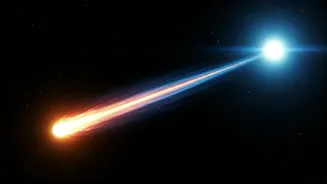An Interstellar Wanderer
Comet 3I/ATLAS, unlike the comets we typically observe, originates from outside our solar system, making it an interstellar comet. Its journey began in distant
space, and now it is on a trajectory that brings it closer to the sun. The fact that it is an 'interstellar object' means it likely formed in a planetary system other than our own. Such comets are rare and provide scientists with unique opportunities. The comet's composition and behavior can offer insights into the environment of the star systems it might have traveled from before its current path took it into our vicinity.
Harvard's Predictions
Harvard scientists are concerned about the growing activity of Comet 3I/ATLAS as it approaches the sun. They predict that it is going to become more active. Comets become active as they get closer to the sun due to solar radiation heating their icy surfaces. This process causes the comet to release gas and dust, forming the characteristic coma and tail that astronomers observe. Therefore, according to scientists, this will allow observers to get a chance to see more activity, possibly leading to a more spectacular display as the comet nears its closest point to the sun, increasing both its brightness and visual size.
Comet Behavior Explained
The behavior of comets is heavily influenced by the sun's radiation. As a comet nears the sun, the ice within its nucleus begins to vaporize, a process called sublimation. This sublimation releases dust and gas, creating a cloud-like atmosphere around the nucleus known as the coma. Solar wind then pushes the gas and dust away from the comet, forming the tail. The comet's activity intensifies as it gets closer to the sun because the increased solar radiation causes more ice to sublime, resulting in a larger and brighter coma and tail. The composition of the comet's nucleus, including the types of ice and dust particles, determines how bright and active it becomes.
Impacts of Activity Rise
The increased activity of Comet 3I/ATLAS could impact observations in several ways. The comet could become significantly brighter, making it easier to spot with telescopes, and potentially even visible to the naked eye. An increased level of activity could lead to the formation of a brighter and more extensive tail, enhancing the visual spectacle. Scientists will use this increased activity as an opportunity to study the comet's composition and behavior more closely. The data collected could provide crucial information about the origins of the comet and the conditions in the interstellar space it has traveled through.
Observing the Comet
To observe Comet 3I/ATAS, one would need a telescope. It is not known precisely when the comet will reach its peak activity, so regular observation is advised. As the comet becomes more active, it could become brighter and more easily visible from Earth. Astronomers often use specific tools like telescopes and imaging equipment. Tracking the comet’s path requires consulting astronomy charts and observing its position over time. The best viewing opportunities often occur during the darkest hours of the night. Interested observers need to find an observation location far from any light pollution to get a clear view.











